Teclib' keeps supporting Christian. This time, in the "Challenge Paris - Nice" 🚴♂️
After only some days since the last race, our associate Christian Osorio Bernal, member of the Club Sardines Triathlon Marseille, is embarking himself, supported by Teclib', into a new goal: "Challenge Paris - Nice".
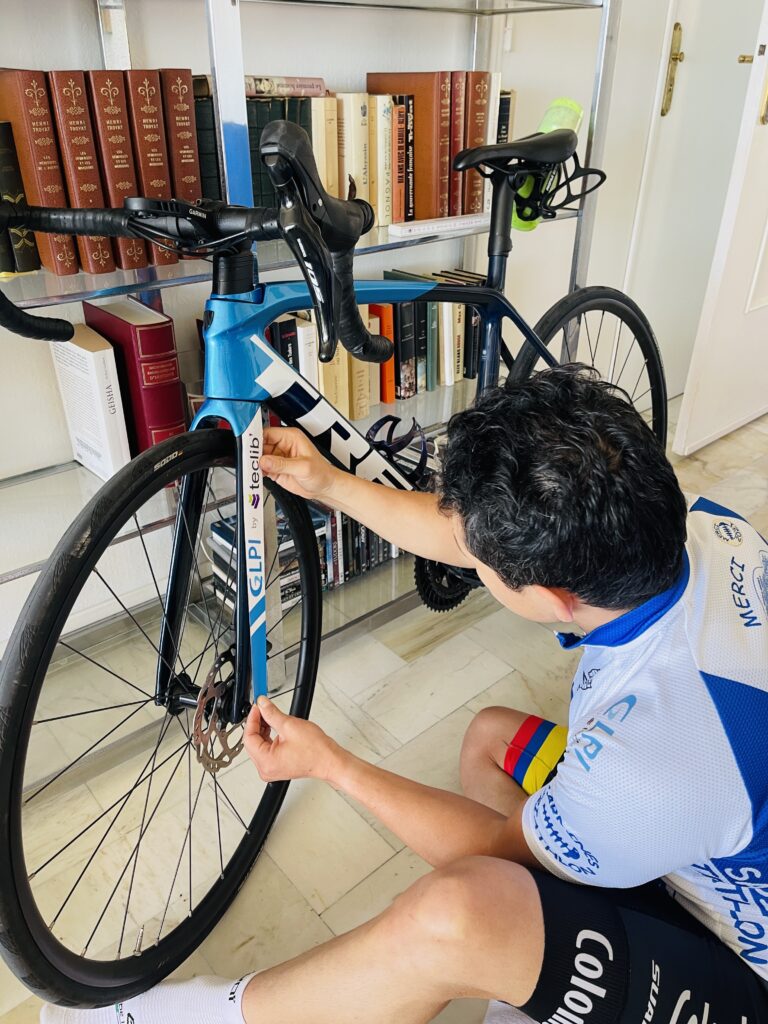
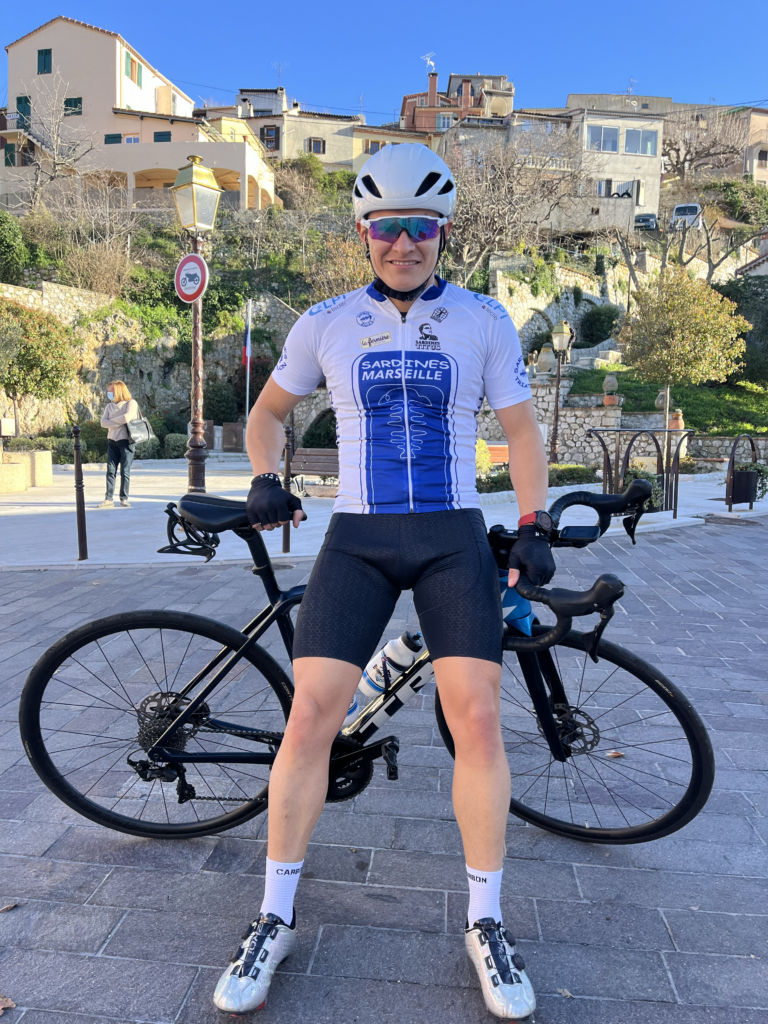
“A week after running the Grande-Motte Half-Marathon, here we are with Teclib on the eve of the Paris - Nice Challenge. Race which resumes the last stage of the “Race to the Sun” starting in cold conditions in Paris and ending with warmer temperatures in Nice. However, this year, cold, rain and snow are on the horizon! Another work of resilience, resistance and determination in sight!
I'm looking forward to being able to do a long outing with a lot of elevation gain, certainly not like the EmbrunMan, but the 140km and the 2800D+ will be felt 7 days after the Half-Marathon! This will allow me to take stock of the state of fitness at 5 months of the Alpe d’Huez triathlon!
So, despite the almost certain absence of sun, let's keep smiling to warm the heart and enjoy the legs with unique landscapes and astonishing views.
Paris - Nice, Teclib’ and I are happy to be part of this challenge this Saturday March 9, See you tomorrow 😀”

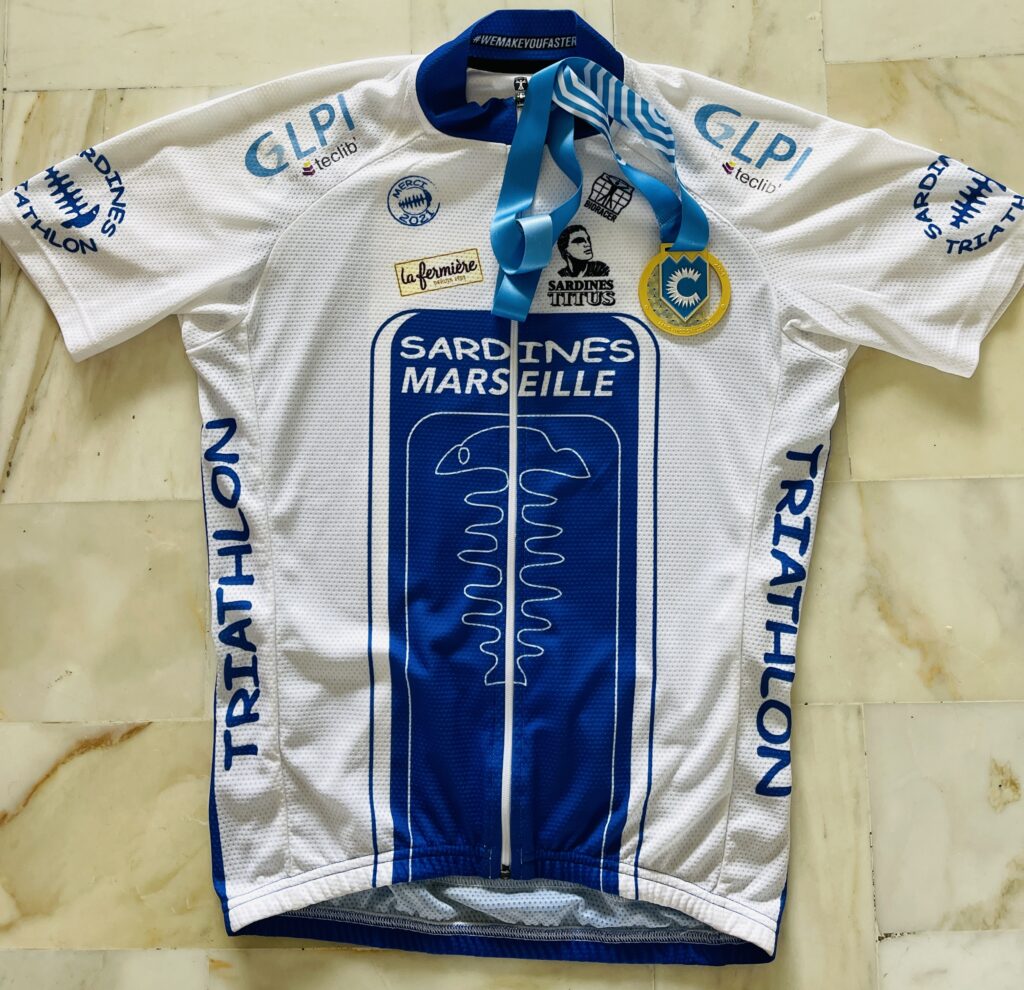




Today, March 11th, Christian has completed his race, and we are eagerly awaiting his initial impressions of this significant challenge! We were thrilled to accompany and support him throughout this journey, which held great importance for him.
“Rainy race... happy race... that was the attitude to adopt on Saturday, March 9th, at the 2024 Paris-Nice Challenge. Cold, rain, and slippery ground are never conducive conditions for achieving top results, but they do allow for a work of resilience, resistance, and determination. Essential qualities for the major goals of this year in July and September!
Good vibes and self-deprecation quickly took over, turning this course into a real challenge!
At the finish line, there was a taste of victory over oneself.
The body sends negative signals to stop being in uncomfortable conditions, but the mind only thinks about reaching the finish line. The landscapes and villages crossed were splendid... La Turbie, Col d'Eze, the great corniches, Villefranche sur Mer…
The fitness level was there, promising for the coming months as we begin triathlon and marathon preparations. I have fond memories of the last two climbs of this Paris-Nice, where a 14% slope for 2km almost made me put my foot down, especially the Col de Quatre Chemins segment!
See you soon for the next races with Teclib' - the official editor of GLPI software.”




We are delighted to announce that Teclib' will be supporting our associate Christian Osorio Bernal, member of the Club Sardines Triathlon Marseille, in the Half-Marathon in La Grande-Motte, France 💪

As you're aware, Teclib' stands behind the aspirations of our employees! Let's recall! In August 2023, Christian competed in EmbrunMan alongside Teclib', serving as his official sponsor!This year, we're continuing this tradition to champion and back Christian, not only our colleague but also an outstanding athlete!
"I am extremely happy to be able to run again under the Teclib - GLPI banner! The renewed confidence and support for 2024 set some very exciting goals throughout the year.In 2 days, I'll be wearing my first bib for a Half-Marathon in Grande-Motte with the aim of beating my personal record and achieving 1h26! It won't be easy, even though the preparation over the past 2 months has generally gone very well. The last two weeks have been challenging, but the work is done, the sessions respected, the heart rate adjusted to the target pace of 4'07min/km ... however, the course of the race still presents many relaunches and turns that will need to be negotiated with caution, muscles will be called upon to be present and ready to endure these intensity variations!This Half-Marathon aims to improve my speed and undertake smart preparation for the two main goals of 2024! There will be a cycling race on March 9, the stage of the Paris-Nice Challenge. With these first two races, the goal is to remind the body and mind that on July 25 and September 1, it will need to be ready!Since the EmbrunMan, the enthusiasm and love for pushing boundaries has known no limits, So I've decided to go for a marathon under 3 hours! I did the Valencia Marathon (Spain) in December 2023 with a time of 3h09! One of the most beautiful races I've done and experienced, so for the sub-3 hours, I'll go to Colombia to run the Medellin Marathon, at 1500 meters altitude, after 9 years without returning! A moment that promises to be rich in emotions, sharing with my family on the other side of the Atlantic, the love for sports and the Marathon!But in the meantime, we haven't forgotten the triple effort, so with Teclib - GLPI, we'll be present at the Alpe d'Huez Triathlon to face a demanding race due to the elevation gain, altitude, and heat on July 25, 2024! An objective that will see 82 Sardines present, an international race and one of the most beautiful in France! Another Triathlon is scheduled for early October in Cali (Colombia), but this will depend on my recovery status from the Medellin Marathon!So, 2024 promises to be rich in emotions, with athletics, cycling, triathlon, and a sponsor who commits once again to this adventure, but this time throughout the year. A heartfelt thank you for this important support throughout this new year!See you soon with the race stories"

“The excitement was high for this first race with a target time of 1h26. I had apprehensions due to several days of accumulated fatigue, a sleep debt that had already impacted my recent training sessions. I must be honest... I hesitated to start when I saw the weather forecast indicating rain throughout and gusts of wind up to 55km/h. These were not optimal conditions to enjoy a race, let alone perform well. Doubt lingered, but the joy of competing and the excitement of running for what I had trained for quickly took over.First bib, first great joy of the year!!Certainly satisfied with the result, but not forgetting to mention the flooded parts of the course, the mud, the ups and downs that had to be negotiated with caution to avoid further muscle trauma or risk of falling. Shoes completely soaked, my water bottle lost at the 10km mark... it was not looking good!But the EmbrunMan and Marathon experiences reminded me that the greater the difficulty, the more beautiful the end!So, I gathered myself, mentally adapted to the conditions, asked my body to follow my instructions, and give its best once again.It was there for me again, connecting with the mindset now ready to set aside the difficulties and embrace the joy that the Half Marathon brings!My condition at 17km was akin to that of 36km into a marathon! That's the goal indeed, the Medellin Marathon (Colombia) on September 1st.The new objectives added to this race have become resilience, endurance, and determination.The result is not bad at all, 1h28:52 sec, despite not achieving the 1h26 goal, I equaled my time record, considering the weather conditions, as in October 2023, I had done 1h28:32 secs at the Semi-Marathon de Vincennes.A big thank you for taking the time to read, see you soon for the next race on March 9, 2024: Challenge Paris - Nice (140km/2800D+) in Nice, France.”

We invite you to join this free webinar presented by our Gold partner in Slovakia - OMNICOM, the subject will be "Service request management supported by GLPI"
On February 1, 2024 from 10:00 a.m. to 10:45 a.m. presented by Miroslav Hlohovsky CEO, Head of Digital at OMNICOM.
Join their webinar “Service Request Management with GLPI”. Explore GLPI’s capabilities for streamlined service requests. Don’t miss this opportunity to improve your understanding and improve the management of your service requests.
GLPI Partner's Day event, held on October 27th in Paris, was a global gathering that brought together over 60 partners representatives from 18 different countries. This event served as a platform for networking, collaboration, and the exchange of ideas among our valued partners, demonstrating the strength and diversity of our international network.

The event took place on the "River Palace" boat, which cruised along the Seine River for 2.5 hours, providing an elegant backdrop for discussions and collaboration. The guests engaged in productive conversations while enjoying panoramic views of Paris's iconic landmarks during the cruise, enhancing the overall Partner's Day experience.
The agenda began with a warm welcome, followed by an opening presentation by our CEO, Pascal Aubry.
This presentation set the tone for the event, highlighting Teclib's vision and the significance of our global network. Mr. Aubry highlighted the importance of the open-source business model, which relies on financial support from customers purchasing GLPI Network support or using GLPI Network Cloud. These financial resources are vital for ongoing product development and the addition of new features, fostering collaboration between Teclib, partners, and customers to ensure the continuous improvement of GLPI.

Next, our guests had the opportunity to get to know the Teclib sales team and meet our channel managers. It was a unique chance to put faces to the voices they collaborate with daily.
Loïc Le Fur, Sales Director, expressed his sincere gratitude to each of the invited members for their presence and dedication to GLPI. He then handed over the mic to the channel managers, starting with Anna Kostrzewska, based in Poland, and Samra Mola, operating from Italy. Both shared crucial data related to our global partnership network, including the number of partners, the worldwide GLPI user count, and the various partner offerings (Silver, Gold, and Platinum levels).




Following that, Polina Marishicheva, Marketing & Communication Manager, took the floor to share some revealing data about the traffic on the following websites:
She also discussed the visibility Teclib offers to partners to expand GLPI support effectively.

Teclib´ Platinum partner EORIS, presented by Alexandre Tur, Sales Director, shared a significant success case of GLPI implementation in a major French engineering company which aimed to standardize its processes across all its French subsidiaries. They approached EORIS to see if GLPI could meet this need, and once again, GLPI proved to be the ideal tool for the job.

Teclib Gold partner, OMNICOM, presented (by CEO Miroslav Hlohovsky) their GLPI project "City of Košice". This project came with several challenges due to its extensive scope. One of the most significant challenges was the need to include all existing IT technician teams from 12 municipal organizations. Additionally, all IT users in the city of Košice, totaling 1,500 users, needed to be integrated. The goal was to centralize all IT requirements into one system, making it easier for users to request services and for technicians to manage them.
You can find the complete article about the city of Košice here: https://glpi-project.org/success-story-omnicom-city-kosice/

These real-users testimonials explain the vital link between Teclib and our partners.
GLPI, one of the most widely deployed ITSM software globally, plays a crucial role in the evolution of both the software and our partnerships.
The day continued with a presentation by Alexandre Delaunay, Head of GLPI Development, who shared the GLPI roadmap, the latest news, including new plugin features and updates, and engaged in constructive discussions with event participants.

The time came for the cocktail reception, followed by a two-and-a-half-hour cruise on the Seine. Our guests had the opportunity to enjoy exceptional views of Paris's iconic landmarks, including the Eiffel Tower, while relaxing on the boat's deck.


The GLPI Partners' Day 2023 was a resounding success, strengthening the bonds that unite us worldwide. This event not only presented the Teclib team but also underscored our commitment to our partners. We look forward to continuing this journey together and exploring new opportunities for the future.
We want to extend our warm thanks to all our partners who made this celebration possible. It's their trust and collaboration that continue to fuel Teclib's growth and prosperity. The Teclib Partners' Day 2023 will remain memorable in our company's history, and we await the next steps in this fantastic adventure.
For more information on our partnerships and solutions, please don't hesitate to contact us: https://glpi-project.org/contact_us/
Teclib remains at your service to answer all your questions and discuss promising future collaborations: https://glpi-project.org/partners/
Thank you once again for your valuable participation in this exceptional event. See you at the next GLPI Partner's Day!
Over the last three days, it-sa Nuremberg brought together the main players of the IT security industry, with approximately 800 exhibitors showcasing their expertise. At the event, GLPI, in collaboration with our partners from Würth Phoenix et Gravitate, took the spotlight as they presented their comprehensive monitoring solution, NetEye. This presentation captivated the attention of visitors, providing them with profound insights into how NetEye seamlessly integrates monitoring and surveillance across all components, including Asset Management, into a centralized solution. "At the end of the day, the primary goal for IT professionals remains constant: ensuring uninterrupted application availability for end-users. Downtimes are simply not an option; they underpin the very core of all business processes," eloquently summarizes Claus Huber, CEO of Gravitate, as he encapsulates the challenges faced by our valued customers.
NetEye, SIEM, and SOC – Seamless Synergy
The visitors showcase featured the application of NetEye with SIEM technology within Security Operations Centers (SOCs), alongside integrated asset management enhancements enabled by GLPI. "We resonated with a multitude of visitors through our presentation of NetEye et GLPI," notes Georg Kostner, Business Unit Manager and NetEye Mastermind at Würth Phoenix. "The positive response at our booth and the subsequent follow-up appointments further reinforce our commitment to in-house development, close partnerships, and platform expansion," Kostner emphasizes.
20 Years of Development with Visions that Became Reality
Two decades ago, Würth Phoenix embarked on a journey to develop a holistic solution for IT monitoring, including GLPI. This endeavor was inspired by the realization, gleaned from numerous Systems Management and Security projects, that existing singular solutions on the market catered to highly specific requirements, leaving a critical gap in comprehensive monitoring. No solution could seamlessly amalgamate all facets of information security and business-critical data into monitoring, thereby creating a real-time depiction of IT impact chains.
Cyberattacks are on the Rise – Path Attack Management with XM Cyber
Another highlight at our partners booth was the unveiling of XM Cyber's Path Management, harnessing the power of artificial intelligence. As an XM Cyber partner, Gravitate showed how Attack Management adopts the attacker's perspective, scrutinizing an entire company's IT landscape through the eyes of an intruder. It seeks to identify the quickest and easiest routes to access the 'crown jewels,' the most precious information within the organization. The analysis results inform the most efficient security enhancement measures. The considerable interest in XM Cyber is no coincidence. Data theft and digital espionage inflict an annual cost of €206 billion on the German economy, with the actual figure likely being much higher due to underreporting. Moreover, the threat of cyberattacks fueled by artificial intelligence has significantly intensified in recent times. XM Cyber addresses this critical gap in cybersecurity.
We're excited to share our experience from participation in the NetEye User Group event, which was organised by Teclib´ Gold partner in Germany Wüerth Phoenix on the 21st of September in Nuremberg. It was a day full of learning, networking, and, of course, fun!

The program of the event included several speakers:
All slides are available in .PDF format on the website of the event: https://gravitate.eu/neteye-user-group/

One of the standout features of GLPI is its ability to offer a wide range of functionalities within a single platform. Whether it's asset management, ticketing, or user management, GLPI brings all these features together seamlessly.
The presentation also highlighted the platform's commitment to improving, and staying at the forefront of IT asset management and ticketing solutions. Teclib's role as the official editor of GLPI was acknowledged as a growing factor in this journey, emphasising the importance of collaboration, community, and open source in the world of IT management.

Teclib and Würth Phoenix are forging a strong partnership aimed at advancing open-source collaboration through the integration of GLPI into NetEye, creating an integrated unified system platform.
This collaborative effort operates on several key fronts, including Research and Development, where both teams pool their expertise to improve the capabilities of NetEye.
Additionally, the partnership places a significant emphasis on Security with a DevSecOps approach, ensuring that the integrated solution maintains the highest levels of data protection and resilience. Furthermore, their joint Customer Service Support and Delivery - Consultancy efforts ensure that clients receive appropriate assistance and consulting services throughout their journey with the integrated NetEye platform.
Users have the option to enhance their NetEye subscriptions by incorporating GLPI on-prem subscriptions, providing a comprehensive view of the extensive value-added services available within the integrated NetEye ecosystem.
With the support of its dedicated community and official partners GLPI is well-equipped to continue its journey from good to great in the world of IT asset management and ticketing.
At Teclib', we believe that in life, it's important to chase your personal dreams. This helps you grow as a person, feel satisfied, and discover more about yourself. One of our employees at Teclib', Christian, had a dream: he wanted to participate in the Embrunman race.

Christian after finishing the EmbrunMan race.
On the 16th of August 2023 Christian completed the race, and we are really happy for him. After crossing the finish line and spending time with his friends and family, Christian shared his experience with us:"I want to tell you about the race – it was the happiest moment of my life so far!The stress started as soon as the signal went off for us to start swimming. I had to swim in the dark, without light, so I followed others until the sun came up. When I got out of the water, my time was 1 hour and 10 minutes – which was great! That was my goal – to swim fast and efficiently. I achieved it!Getting ready for the biking part, I realized it was going to be a very long day, at least 7 hours and 30 minutes of cycling before the marathon. I cycled for 8 hours with a 30-minute delay. I decided to be careful on the downhill parts to avoid accidents like the one I had three weeks ago. On the uphill sections, I kept my energy steady at 200 watts and managed the Izoard pass.Around kilometer 140, I had doubts, but my coach encouraged me. He said I was behind by 20 minutes, but I was strong where others were not, especially in the marathon. EmbrunMan is tough mentally, but I could do it. I knew it was going to be hard, and I signed up for it, so I kept going.Finishing the bike part was great, but the moment I looked forward to the most was the marathon. My coach gave me a strategy: run at 5 minutes and 10 seconds per kilometer for the first 14 kilometers, then at 5 minutes and 25 seconds per kilometer for the next 14 kilometers, and then just do my best for the last 14 kilometers.I followed his advice, sometimes even running faster than I expected. I kept my energy in check and maintained a steady pace. Gradually, I caught up with those who were ahead of me. I felt like I was floating, even though I was tired and dehydrated.

Christian running during the EmbrunMan race.
The last 14 kilometers felt never-ending, and I thought I might collapse. I saved my last energy gel until I felt like I was losing control at kilometer 39. Taking it gave me the strength to cross the finish line. I saw my Colombian flag held by a fellow athlete, and I proudly finished the race.I heard my mom's voice and the cheers from my fellow athletes from Les Sardines Club throughout the race. It took me 13 hours and 54 minutes, but I achieved my secondary goal of finishing in less than 14 hours. The main goal was to complete the marathon in less than 4 hours, and although I did it in 4 hours and 10 minutes, my friends called it "the comeback" because my coach said it was an impressive marathon.I finished feeling dizzy and dehydrated, but my triathlete friends assured me it was normal. They told me to rest a bit in the medical tent. That's how I ended the most anticipated day of 2023 and the most wonderful day of my life so far!My mom was a huge support before, during, and after the race. Seeing her along the course gave me energy and made me proud. Friends and other members of Les Sardines Club were there at different points along the 231-kilometer race. Without them, no one could finish a race like this. The medal I earned belongs to them too."
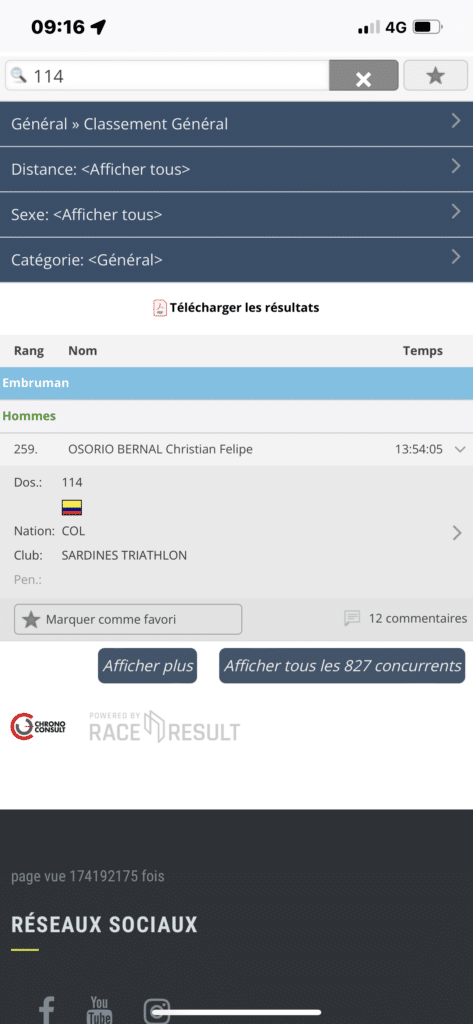
Christian's results after the EmbrunMan race
Teclib' is thrilled to sponsor and support Christian in his athletic journey. We believe in the values of determination, perseverance, and pushing boundaries, which Christian exemplifies through his participation in the Embrunman race. We are proud to stand behind him as he embodies these athletic ideals.
"With only a few hours left before the EmbrunMan event, I'm starting to feel a good kind of nervousness! I've been getting ready for this day for 8 months, working with my Club members, family, and friends. It's all been leading up to August 15.As the time goes by, I'm feeling more and more excited and happy. I can't help but imagine myself crossing the finish line tomorrow during the race!

Christian Osorio prepares for Embrunman 2023.
The bike ride I'm going to do will be the longest one I've ever done. But I feel prepared because I've been training with my coach and the Les Sardines Triathlon Marseille Club.
The plan for eating and drinking is all set! I've included my race plan and imagined how it will go".

This is what I'll use during the race in the three different parts. Each thing has an important job, and I can't forget anything. If I do, I'll have to make choices during the race to adjust my speed, stop to eat and drink at the planned times, and change how I get my energy and water. The weather will be very hot, so I think I'll need to drink about 800ml of water every hour for 12 hours. I'll also eat about 66g of sugar every hour for 12 hours, and I'll have to keep taking minerals to help my body hold onto water. To stay safe in the sun, I'll wear a white helmet, a cap, and use SPF 50 sunscreen for kids! I've got the tools to change my bike tire two times if I need to.

Wow, I'm so excited to do this race with a big uphill climb of over 400 meters! I want to feel every step of the way up to the 42nd kilometer. I know there will be times when I feel sure of myself, times when I doubt, feel scared, zone out, and even times when everything seems unclear. But these moments will make me think and grow, and I'll make important choices.
This kind of challenge is like practice for life. It will help me handle everyday challenges calmly, with discipline and accuracy! I'll be really happy when I finish this triathlon that I'm looking forward to so much. I hope I'll have a medal around my neck tomorrow! 🏅
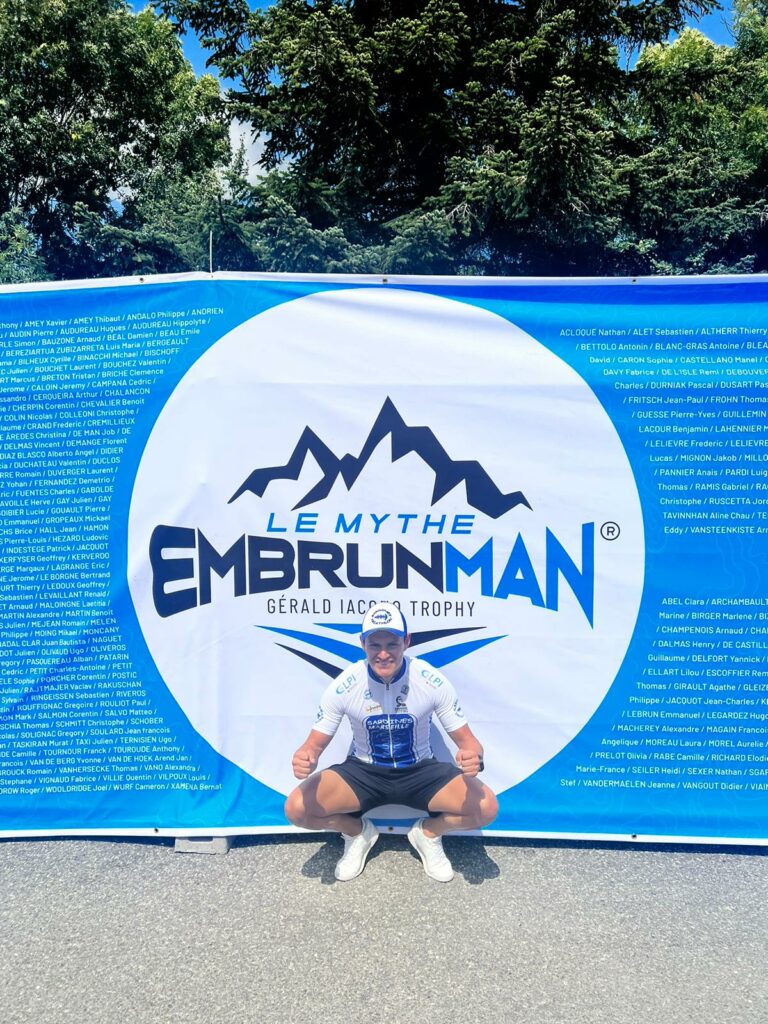
Participants:
Hatomi – Mateusz Kalisiak
Sokół IT – Krzysztof Sokół, Krystian Pocheć
SpearDevs – Bartosz Guździoł, Ireneusz Rytlewski
Sławomir Szmulik
OMEGA IT – Adrian Czuchaj, Michał Kulesza
Transcription:
Welcome everyone to our first GLPI RoundTable. This is the first such event in Poland, during which we will discuss GLPI from the point of view of the partner, editor, as well as the end customer.
In today's meeting, we will basically touch on the three most important topics:
The first is why do users love GLPI? What convinces them to choose this system? Then we will talk about the power of open source and how it affects GLPI, and then we will move on to what are the most important functionalities of the system itself. My name is Anna Kostrzewska and I am a Channel Manager at Teclib. I work directly with partner companies and that is why I will be conducting today's meeting.
As for the participants of today's meeting, Mr. Mateusz Kalisiak from the Hatomi company is with us. He is the head of the team responsible for the design, implementation and development of the OSS/BSS platform and ITSM systems. Hatomi has been operating on the IT and Telecom market in Poland and abroad since 2011 and the main focus is SoftwareHouse, DevOps and GLPI.
Then I warmly welcome Sokół IT and there is Mr. Krzysztof Sokół, CEO, and Krystian Pocheć, an IT specialist. They also specialize in web development, GLPI of course, and retail system implementation, and are very active in the GLPI community.
Then, welcome to the SpearDevs company, represented by Bartosz Guździoł CEO and Ireneusz Rytlewski CTO. They also specialize in GLPI and e-commerce solutions and web application development. On behalf of the host, I would like to warmly welcome Mr. Sławomir Kulik, who is the head of the IT Department at the Specialist Hospital of the Ministry of Interior and Administration in Gułochazy and privately a lover of GLPI and Open Source, and welcome the Omega IT company, represented by Adrian Czuchaj, who is an IT helpdesk specialist, and Michał Kulesza, who is responsible for sales and customer contact. Omega specializes in server administration, helpdesk and networking, and of course GLPI. Of course, more information about our event participants can be found on our website in the Partners tab.
Partners provide support in the field of GLPI On Premise et Cloud, development and the broad range and use of our system.
As the first part of the participants' presentation is already behind me, I wanted to move on to the first topic, which is the question: What distinguishes GLPI from other systems? And why do customers love this system? Of course, many of them have many functionalities, such as asset management, problem management, project management, documentation management. It also enables comprehensive management of the organization's resources.
However, the question arises what distinguishes GLPI? And why do customers love it? I would appreciate your opinion on this.
Maybe Mr Krzysztof Sokół?
What can I say…. Customers like GLPI because it is actually very versatile. It allows you to obtain many functionalities in one place, which in fact are either unavailable in other systems or require the implementation and activation of additional elements that undermine the entire project.
In fact, in the GLPI system we have all or a large part of the functionality that is needed to properly manage IT resources already available in the package. In addition, the possibilities it gives are that it can all be expanded. That is, the system is flexible enough that all the possibilities that a given client or person wanting to use the system wants to implement are possible to run.
It is known that open source gives this very nice possibility. The system is available as far as the source code is concerned, i.e. anyone who may have the opportunity to analyze this code can also supplement its functionality with such elements that are needed at a given moment or possibly commission such an extension.
It is very interesting what you said, and in fact, such a thought arises, because it follows that GLPI is able to improve the overall productivity and efficiency of the entire functioning of the company. Do you agree with this opinion? What experience do you have here?
We have such experience that simply the system, if it is well implemented and launched, then allows the managing person to have direct and relatively quick access to all necessary information on, for example, the state of computer equipment that is running or used in a given company. In addition, you can make a list of information about service failures that were performed at some time on a given equipment.
This type of information without a system like GLPI is actually extremely difficult to obtain. However, here we have everything ready and available very easily and quickly, so in this respect such ease in obtaining the information needed to properly manage the equipment resources. The system is simply amazing.
I am also curious to meet the other side of the user, Mr. Sławek. Do you also share the opinion of Mr. Krzysztof?
As much as possible only from the user's side, giving context to people who will watch it. I work at the local government units, for which GLPI is, first of all, an inventory of hardware and software, i.e. the fulfillment of the provisions of the National Interoperability Framework series, which impose the obligation to conduct such an inventory.
And GLPI, first of all, wins because it is free, so you can implement it yourself. And what, in my opinion, distinguishes GLPI most from other tools is that it is not a tool only for IT departments.
It has been recognized that inventory management of hardware and software primarily falls under the responsibility of administration, focusing on fixed assets, equipment, and low-value assets. However, thanks to GLPI, this extends to encompass all records that the administration holds for each equipment type. As Mr. Krzysztof pointed out, GLPI allows the inclusion of not only IT equipment but any equipment that serves a specific purpose.
In the case of a hospital, this includes a comprehensive record of medical equipment. An authorized person can access this information based on their position, room, or department, enabling them to view all the equipment they have at their disposal, including values, supplier details, contracts, and other relevant elements. Previously, this would have required the use of multiple tools, but now, with GLPI, all the necessary management information is consolidated in one place.
In many instances, particularly in public administration units, there is a misconception that software for recording purposes is solely intended for IT departments. However, this assumption is incorrect. The more departments we integrate into this system, the smoother and more efficient it becomes to manage the entire hardware resource, encompassing not just computers, but all other equipment as well.
Thank you for your comment. We have observed market trends in Poland that show that this system is not limited to a single type of customer. It caters to customers from various industries with different needs. Do you also interact with clients from different industries with diverse requirements? It is safe to say that this system is suitable for almost every industry.
That's right. If there are any functionalities that the system does not currently have, there is certainly an option to add them to meet specific needs.
As partners, you have access to our technical department, which can develop or address any specific requirements. Open source has been highlighted as a major advantage of GLPI. It means that GLPI is both free and open for modification. This allows organizations to adapt it according to their individual needs.
What do you think about the impact of the Open Source community on GLPI?
If no one has shared their thoughts yet, I'll start the discussion. In fact, I'd like to expand on this topic a bit. GLPI utilizes open source technology, which has a long-standing history and proven value. We specifically chose to incorporate open source solutions into GLPI. Considering the frequency with which we use open source solutions, we highly recommend our clients to consider GLPI as an open source option, particularly for security-related matters.
Absolutely. We greatly appreciate the availability of the source code. In today's context, as we discuss cryptocurrencies, it's essential to have many individuals reviewing the code, testing it, and attempting to identify any potential vulnerabilities or weaknesses that could impact users. Having a large community involved helps to ensure a more secure and reliable system.
The involvement of individuals, who often engage in software development as a hobby or out of their belief in a particular software, is what contributes to its progress. Teclib alone would not be able to conduct extensive testing, research, and attempts to break the solution as efficiently as the collective efforts of the entire community. This collective collaboration leads to faster development, increased security, and the prompt detection of errors and issues in the IT realm.
It's important to acknowledge that no tool or software is perfect. They all have their share of bugs and problems. The key is to identify and address them as quickly as possible.
In my personal opinion, this is where the value of open source truly shines. However, I also welcome others to share their thoughts and challenge my perspective.
Now, I would like to hear your story and understand how you came to this conclusion. I won't undermine your opinion because I agree with it. Different theories exist within the industry, with some arguing that open source is more secure and others claiming the opposite. Personally, I lean towards your view that having a community that checks, corrects, and tests contributes to increased security.
However, I wanted to draw attention to other topics, that is, open source is free. This may be a bit of a controversial statement. However, access to the code is actually free. This is usually a huge advantage, but also a disadvantage. The point of view depends on the point of sitting. Because now yes, maintainability - depends on the community. If the community is large, there is no problem with maintainability. Many, many people use the solution and actually need some functionality, development, etc. for their needs. He often shares this with others. However, with a small community, there can be problems.
Fortunately, in my opinion, the GLPI solved it in a very simple way. I mean, there is Cloud support and as if GLPI is also developing a Cloud version as part of its internal team, thanks to which open source simply uses it. And in my opinion, this is such a sensible approach to open source. So, in fact, there is this commercial aspect at the back, which allows you to organize at least updates of this software somewhere.
And what I wanted to mention is that it is definitely open source, which leads to a large possibility of customizing the solution to your own needs. I mean, we have a solution that suits us to some extent, but we can't really transform it even within our development team to meet our expectations, which is usually not an option with proprietary, licensed software.
And that's all I want to add here from myself in this context. Thank you very much for the comment and Bartek the same. It was very enriching and I am curious about the perspectives of other participants, because Bartek and Irek's answer was really exhaustive, but maybe someone would like to add something, comment, because of course everyone here works in GLPI, etc. However, the perspectives may be different. I am very curious what you think about this.
I agree with the earlier statements made by my colleagues at SpearDevs. I want to highlight another aspect of open source software, particularly in the case of GLPI. It has a significant community presence, not just in Poland but also internationally. This dynamic development, driven by a large user base, sets open source software apart from commercial solutions, especially when it comes to incorporating additional features that are in high demand.
Although the initial stages of development may sometimes be challenging, once the software gains traction, it progresses rapidly. Open source software tends to evolve quickly and efficiently. On the other hand, commercial solutions often face limitations in terms of flexibility and speed.
I believe we can all agree that the combination of open source and GLPI has greatly benefited the functionality and security of the entire community. As an open source system, GLPI offers numerous features that are highly valuable to many organizations.
Furthermore, GLPI has undergone significant changes with the release of version 10. I am curious to hear your thoughts on GLPI 10 and how you perceive its advancements.
What functionality do you think is the most important and important from a business point of view?
Since we're discussing this topic, I'd like to share my thoughts as well. Through conversations with various individuals, I've noticed that potential users of GLPI are attracted to its high value, particularly its user-friendly interface and construction. The new look of GLPI 10 is highly praised, as it enhances readability. Clients often emphasize the importance of transparent client information, which GLPI provides excellently.
The ease of working with GLPI is another standout feature. The clear visibility of tiles allows users, like Mr. Krzysztof mentioned, to manage equipment inventories effortlessly. Our helpdesk team can easily oversee equipment, identify defects, and manage software-related tasks. We'll discuss this further with Ania.
When a client tries the Cloud 45-day trial version of GLPI and realizes they need a user-friendly, efficient, and fast solution, the decision to choose GLPI becomes evident. They can choose between the open source product or the On Premise option with Teclib's additional support. Alternatively, the Cloud version is an excellent choice for clients with smaller teams, such as a single employee managing their company's helpdesk. This flexibility is a significant advantage.
That's all from me for now.
Maybe Krzysztof?
In summary, I'm particularly impressed with the transition from version nine to ten, especially the introduction of the Native Inventory agent. We initially used our own mobile application for ticket and resource tracking, but it wasn't efficient. Switching to GLPI and OCS improved the situation, although there were challenges with the previous asset tracking virtual machine.
The installation process and intuitiveness were not the best, and there were many bugs. However, the new Inventory Agent performs much better, especially with legacy hardware and software. The installation has improved, and I've noticed a useful feature of automatically reading the ID of remote software. This is especially beneficial when working with a large number of resources, as it eliminates the need to manually enter each resource and ensures technicians have remote access.
Overall, the transition to GLPI 10 has brought significant improvements and enhanced functionality.
In most cases, when a resource is added to GLPI, technicians will have remote access to it. This feature is quite impressive. Regarding version 10, that's all I wanted to mention about its benefits. Krzysztof, do you share the same opinion?
Absolutely, I agree. The native inventory system in GLPI is impressive. It provides a comprehensive view of equipment and allows us to track its history, including installations and changes over time. This feature was available in previous versions as well. It's beneficial to have a complete history of a resource's journey.
In my experience with Omega, we initially used version 9.5, which wasn't as visually appealing. However, the tenth version is much more user-friendly, with a more intuitive and colorful interface that is easier for both end users and our team to navigate.
We primarily utilize the ticket system module and the inventory feature. As my colleagues mentioned, using the agent and clients allows us to consolidate all resources into one system. Previously, we had separate units for different clients, with specific assignments for computers, software, and network devices. Now, everything is streamlined and accessible from a single place. It has greatly improved our efficiency and the management of our inventory.
Do you share similar experiences and thoughts?
So for now we have here one big opinion that Native Inventory is the most appreciated GLPI functionality. Mr Sławek, do you also think so?
I want to share a story about version 10. It goes back to when GLPI introduced a new feature: the dashboard with nice graphs. I believe it was in version 9.5. During that time, a company responsible for maintaining our equipment records software paid us a visit. They were familiar with the software used by a large Polish company. We wanted to discuss contract-related matters, so I performed a search in the main GLPI search engine. To my surprise, I had all the contract information in one place, including details on who the contracts were with, their start dates, and whether they were still active.
The person from the other company looked at me with surprise and asked, "Is this the same software we use every day?" I confirmed it was, but they thought their software was exclusively for accounting, not for other purposes. It was a pleasant surprise for them to discover that GLPI is open source. I tried to convince them to consider using GLPI, at least for the ticket system, but they were obligated to implement a different solution.
Many companies tend to stick to their existing software solutions without considering the need for interface updates or user feedback. However, GLPI's active community continuously develops the software, transforming what used to be plugins into standard features. This professional and polished appearance surprises many, as they don't expect such a comprehensive and user-friendly solution that can be downloaded and run independently.
While there may be challenges associated with using GLPI, they can be overcome with proper support. In terms of appearance, GLPI stands out as a mature software option, even compared to commercial systems. Its intuitive interface caters well to end users, who may not be as technically inclined. The simplicity and limited view of the interface reduce the chances of users getting lost or overwhelmed. Offering training and presentations on how to use the system effectively further enhances the user experience.
The user interface of GLPI is highly praised for its ability to streamline and enhance the efficiency of an entire company. It eliminates the need for time-consuming translations or guidance on how to navigate the system. It is designed to naturally adapt to different functions and work seamlessly with various systems.
GLPI is not your typical open-source software. It operates on a two-stage approach, with a strong editor ensuring the core functionality works well and addresses bugs, development, and intuitive GUI enhancements through major updates. The other driving force behind GLPI's development and expansion is its partners. They contribute to the system by building plugins and suggesting improvements that may not have been considered by Teclib or others. This collaborative effort creates a robust support network, allowing GLPI to become more functional and accessible to a wider audience.
The support from partners is a crucial aspect to highlight. While Teclib serves as the core, they are open to suggestions and feedback from partners and customers. GLPI is a solution built and nurtured by these partners who implement and maintain the system, ensuring it meets the specific needs of different markets.
At the beginning, we talked about the type of customer type, also characteristic of the Polish market, because we see that each market has different tendencies and different needs and different preferences regarding the system, be it GLPI On Premise or GLPI Cloud, so each market is characterized by its specificity. I would like to return here to one topic about inventory, because as we know, support for version 9.5 ends at the end of June. Therefore, companies with previous versions should consider migrating to version ten.
Free migration to Cloud service is available, of course, with the new version of Cloud. How do you see this migration?
May I share something? Absolutely. Keeping the software updated is highly important and essential. If a particular version of the software is no longer supported, it is advisable to consider updating it, depending on specific requirements and issues.
Let's be honest, if the application doesn't require internet access and we don't encounter any specific problems with its functionality, it might be fine to stick with the previous version. However, if we want to utilize certain features or address any issues, an update can be beneficial. It's worth noting that updating may pose challenges if there are many installed plugins that are not easily upgradable or supported in the new version. This aspect should also be taken into consideration.
Fortunately, there is support available from Teclib and their partners in this regard. They assist with migrations, including transitions from open source versions to paid (cloud) solutions, often providing these services at no cost. Qualified partners have the expertise to perform such activities, including integrations and version migrations. Regarding the cloud version, it's worth mentioning that GLPI offers a 45-day trial period with access to 25 plugins. Users can explore the software without any fees or providing credit card details. It's a great opportunity to try it out and see if it meets their needs. Additionally, partners are typically open and willing to provide demos and further information about the functionalities.
Certainly, GLPI offers both cloud and on-premise versions. Before we conclude, I would like to hear from each of you, in just a few sentences, how you personally perceive GLPI. If you had to describe it in two or three sentences, what would you say? Let's start with Krzysztof to complete the circle.
So, for me, the GLPI system is such a universal, comprehensive resource management system and a ticketing system at the same time. All in one. To be honest, And this is not the end, because the flexibility of this system allows you to expand it according to any needs that come to mind.
What about you, Kristian?
For me, on the technical side. First of all, it is a tool that allows me to check whether I am flooded with tasks when I come to work in the morning. What should I do? What was I supposed to do today? I have such a nice queue of requests, I have priorities and I know exactly what I should sit down for first and get to work also helps much better in organizing work on a daily basis. Also, when it comes to records, as we have mentioned many times during the meeting here, what should I pay attention to if, for example, equipment appears repeatedly in my applications? Should we think about changing it? Is offering something new to the client a very nice tool that makes sure that you don't just get stuck on some strange thing.
And that he could simply set priorities as they should be set, and not as I see it just when I come to work in the morning. So much from me too. We even did some kind of test to see whether it is suitable as a CRM system. Well, most definitely. We adjusted the system so that thanks to the possibility of combining tickets, adding private notes, and sending leads to the technical department, we managed to create a really cool, compatible and efficient solution.
What about Matthew?
For me, GLPI is primarily plug & play. Very easy to run, very easy to use properly without TS, without any specialized IT knowledge and anyone can run it and anyone can start using it. Another important aspect is the flexibility of GLPI. It allows for easy development and addition of new functionalities through plugins. Additionally, the built-in API enables customization and organization of units within the system, providing a high level of flexibility to tailor processes to individual needs.
Moreover, GLPI's multi-functionality is noteworthy. It encompasses various domains such as inventory management, ticket management, knowledge base, project management, and budgets. These modules seamlessly interact with each other, allowing users to utilize specific modules or integrate them to gain comprehensive information. In summary, GLPI is like a plug and play solution, offering flexibility and completeness.
It's great to see that GLPI is viewed from various perspectives, highlighting its versatility and usefulness. For Adrian and Michał, it serves as a ticket management and inventory tool, streamlining client segregation and offering centralized access to all necessary information. The abundance of plugins further enhances its capabilities, providing numerous opportunities for customization and expansion.
As for Michał, GLPI represents a constantly evolving solution with endless possibilities. Each new case or potential user brings the excitement of exploring uncharted territory, as there's always a plugin or solution that can address specific needs. It's a learning journey for both Michał and others, as they discover new ways to propose and implement interesting solutions.
Overall, GLPI is seen as a powerful tool that simplifies processes, organizes data, and offers a world of potential, appealing to both technical and business-oriented individuals.
Mr. Slawek?
I'd like to add two important points from my perspective. Firstly, GLPI has greatly improved our knowledge management by centralizing dispersed information previously stored in old notebooks across various technical departments. Now, we can efficiently manage not only medical resources but also other valuable knowledge from a single platform.
Secondly, the flexibility of GLPI's API is truly remarkable. It enables seamless integration with commercial databases, allowing us to retrieve and consolidate data from multiple systems into one. This simplifies the user experience, as they only need to adapt to a single interface while having access to comprehensive information. GLPI also helps ensure data quality by organizing fields separately, preventing unnecessary mixing of information like comments with serial numbers or contact details with contract numbers.
This comprehensive database proves to be unexpectedly useful, even for individuals who may not initially see the value of entering extensive information. For example, IT specialists may not realize the strategic importance of financial data for budget planning, which is crucial for public institutions. By having this information readily available within GLPI, we no longer need to approach the accounting office for specific statements, saving time and effort.
It's just faster. It is also knowledge management and a very big time saving. If I may, I would like to add something here in reference to the statements of Mr. Sławek, Mr. Michał and Mr. Adrian.
Yes, the GLPI API provides numerous possibilities for integration with various systems. Adrian and Michał mentioned earlier that they are constantly learning new things about GLPI, and I agree with them. The range of functionalities in GLPI is extensive, and while we haven't specifically discussed plugins, they play a significant role in covering a wide range of use cases.
It's worth noting that users have the option to develop their own plugins for GLPI, extending its capabilities. The development documentation and coding standards provided by GLPI are well thought-out and make development easier.
Irek, thank you for your comment. With the multitude of plugins available, GLPI can cater to diverse needs. The 45-day trial version allows users to test up to 25 plugins and evaluate their performance. These plugins are an integral part of GLPI's success, enabling the addition of various functionalities. In our experience, we have successfully created client-specific plugins and integrations to meet unique requirements.
And how about Bartosz?
I'm glad I am here to share my perspective. While many of the previous speakers have focused on technical aspects, your viewpoint on business issues is equally valuable. One important aspect to highlight is how this tool can make our daily work more efficient and streamlined.
As someone who appreciates finding ways to simplify tasks, I understand the value of offering clients a tool that supports their work. This can come in the form of automation or semi-automation, which helps to reduce human errors. For instance, collecting information about devices can be done almost automatically, saving time and effort. Additionally, the integration of helpdesk and financial aspects into one cohesive system, along with the ability to connect with additional tools, further enhances the benefits.
The open-source nature of the tool provides us with significant opportunities to streamline our work and prevent mistakes. Ultimately, the purpose of IT is to make our work easier, decrease the number of tasks we need to handle daily, and foster innovation.
So I personally am a fan of the fact that this tool is so complete and mature enough, especially in this latest version, that it simply facilitates work where before a lot of people were needed for the entire inventory to look after documents, etc. It partly eliminates the number of people that are needed to oversee it all.
That's all from my side. You know, I could repeat a lot of things. I agree with everything that has been said here. Of course, I don't deny it. But I simply mean that as if answering what is most important to me, fortunately this point stayed until the very end, you were afraid that someone would take advantage of it.
First and foremost, GLPI aims to make your job easier by eliminating repetitive tasks and ensuring important reminders, such as license renewals. It provides the ability to create task packages that systematically remind us of important events throughout the year, preventing us from forgetting anything.
We appreciate the opportunity to discuss GLPI, Open Source, and its various features from different perspectives. If viewers have any further questions or inquiries, they can reach out to us through the Contact tab on our website, glpi-project.org. We are open to discussions, eager to address queries, and willing to consider new projects. We highly encourage everyone to test the 45-day version, which offers a tangible opportunity to experience the system's practical and substantive capabilities.
Thank you all for participating, and we hope to organize another GLPI discussion soon, focusing on selected topics chosen collectively.
Thank you for the invitation and the opportunity to share our thoughts.
On Thursday, June 1, 2023, all Teclib’ employees gathered for the half-yearly corporate event.
Our colleagues have traveled from different parts of France and Europe to come and spend time talking about current and future projects.
The Teclib' Day brings us together and strengthens our bonds, making us a tightly-knit team.
The agenda of the Teclib’ Day:
The day begins at 9 a.m. with a breakfast to welcome everyone and provide an opportunity for casual conversation before the presentations commence.
Each Business Unit of the company presents its strategies, developments, objectives, and future visions.
The session kicks off with Pascal Aubry (CEO) taking the lead.
Buy The Way: https://www.buy-the-way.com/ :
Chloé Robin presented the agency's latest updates, including the acquisition of new clients, the evolution of turnover, projections for the current and upcoming years, and their goals.
Hodei: https://www.hodei.net/ :
Franck Pâtissier presented their visions and expectations, expressing their commitment to further contribute to the success of the Odoo project. They also discussed their prospects for the end of 2023.
Edition :
GLPI takes great pride in celebrating its 20th anniversary and extends heartfelt gratitude to all the contributors and the entire community who follow, support, and utilize our tool.
François Legastelois, the edition director, is keen to emphasize the total involvement of his team, including R&D, core-team, the Cloud team, Administrative, Marketing, Professional Services, our sales representatives, and Legal.
We would like to highlight the remarkable achievement of our work-study developer, Marie Bressy, who has created a plugin that seamlessly integrates Centreon and GLPI. This integration allows users to access key data of their monitored machines in Centreon, directly within the GLPI interface. Through a new tab available on the respective computers, users can view not only general host information but also the services installed on it.
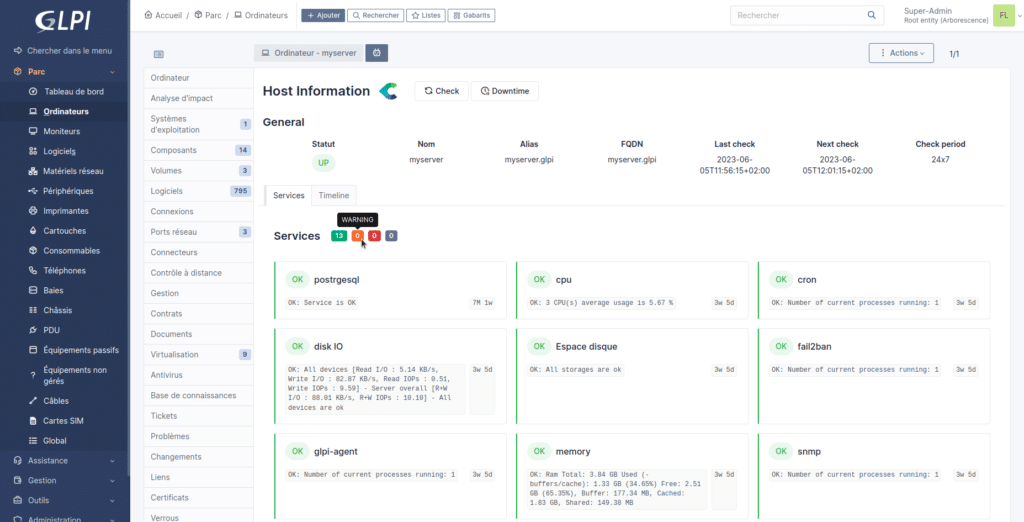
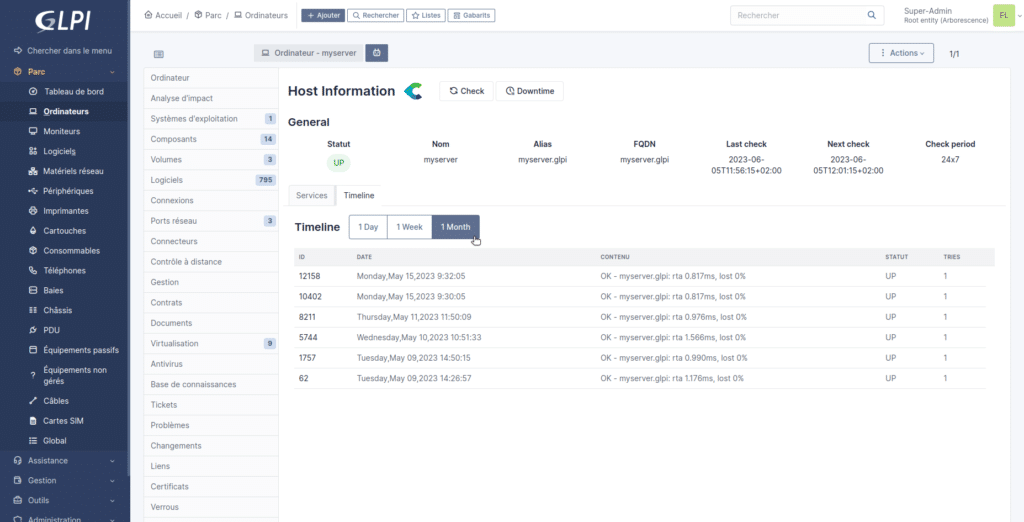
During the presentation, our trainees on the development team were recognized for their significant contributions to the advancement of GLPI.
For instance, Samuel developed a Cloud Inventory plugin. This plugin retrieves information from machines hosted by various Cloud providers and effectively inventories them. Samuel achieved this by utilizing the APIs provided by different providers such as OVHcloud, AWS, Scaleway, Azure, Google, and more. Using this data, the plugin creates or updates machine records within the inventory. Additionally, the plugin functions as a GLPI agent, providing supplementary information on machine backups and backup details. It runs automatically once a day, but can also be executed manually.
Teclib' not only trains its interns but also seeks to retain them through work-study programs. We are always on the lookout for fresh talent! Please, contact us if you wish to work with us: jobs@teclib.com
GLPI highlights in 2022/2023:
Following the presentations, it was time to enjoy a delightful lunch at the Domaine du Tronchay, basking under the beautiful June sun.
After that there were formed cross-functional working groups, bringing together teams from different sectors to brainstorm and propose areas for improvement across various domains, as well as generate fresh ideas.
To conclude the day, we indulged in apero accompanied by live music. The evening continued with a BBQ and party!
Thank you all for coming to share this Teclib’ Day 2023, we look forward to seeing you next time!